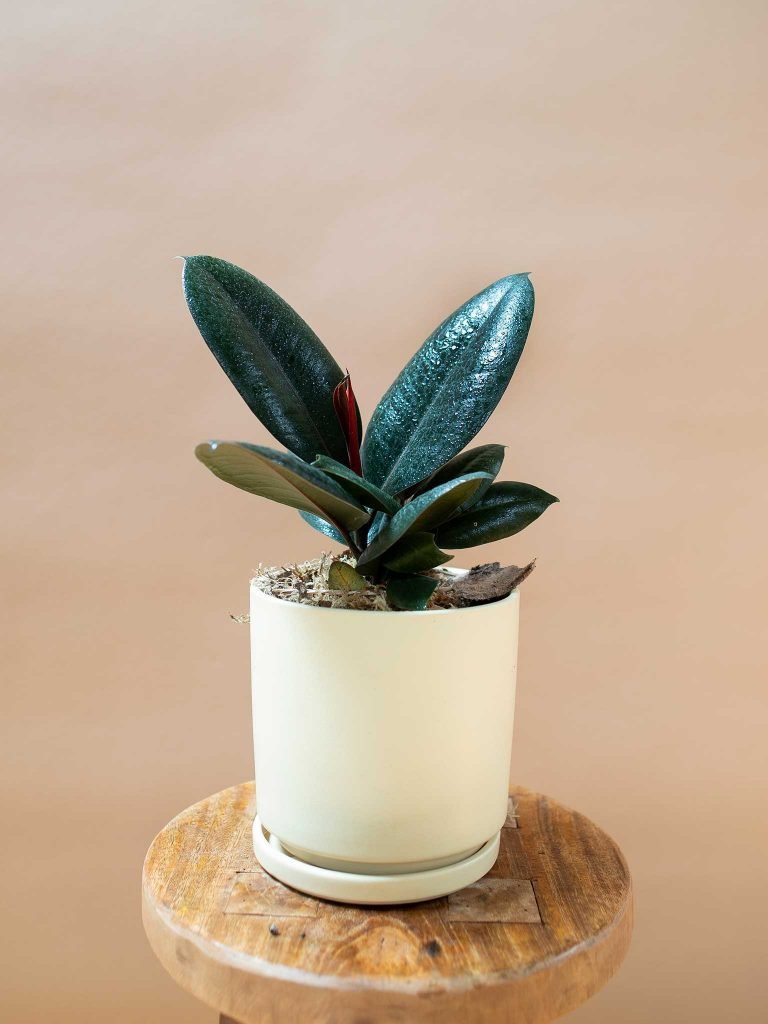Botanical Name: Ficus elastica “Burgundy”
Nicknames: Burgundy Rubber Tree, Rubber Plant, Rubber Fig, Rubber Bush, Indian Rubber Tree
The Burgundy Rubber Tree is a full plant that has large, almond-shaped leaves that range from burgundy to almost black. It is the perfect plant for a bright spot in your home. It is a strong and sturdy tree that can be used as a decorative plant or accent to your space. While it can reach heights of almost 40′ in its natural habitat, it typically will not get much larger than 8′ tall in your home. The large leaves convert carbon dioxide into oxygen, absorb harmful air pollutants, and eliminate mold spores and bacteria in the air.

Let There Be Light! 🌞
Finding the Sweet Spot for Your Rubber Fig
Light is a crucial factor in the health of your Burgundy Rubber Tree.
- Bright, Indirect Light: Aim to place your plant in a spot where it receives plenty of indirect sunlight. A spot near an east or west-facing window is ideal.
- Watch Out for Direct Sun: Too much direct sunlight can scorch the leaves, causing them to lose their stunning burgundy hue.
- Low Light Adaptability: While it can tolerate lower light levels, its growth may slow, and the leaves might lose some vibrancy.
Water Wise: Balancing Moisture for Your Rubber Plant 💧
Navigating the Hydration Needs
Watering your Burgundy Rubber Tree rightly is a balancing act.
- Consistent Moisture is Key: Keep the soil evenly moist, but never soggy. Overwatering can lead to root rot.
- Feel the Soil: The best way to know when to water is to feel the soil. Water when the top inch feels dry.
- Seasonal Adjustments: Reduce watering in the winter months when the plant’s growth slows down.
Creating the Ideal Environment 🌡️
Tailoring the Perfect Home for Your Indian Rubber Tree
Your Rubber Plant isn’t overly fussy, but it does appreciate a comfortable environment.
- Stable Temperatures: Aim for a temperature range between 60-75°F (15-24°C). Avoid sudden temperature drops or cold drafts.
- Humidity Loves Company: These plants enjoy a bit of humidity. A regular misting or a humidifier can work wonders.
- Room to Grow: Ensure it has enough space as these plants can grow quite large.
Witness the Growth: Understanding Your Rubber Bush 🌱
Celebrating Its Vertical Ascent
- Impressive Growth: Under the right conditions, your Rubber Tree can grow quite tall, making a striking statement.
- Pruning for Shape: Regular pruning can help maintain its shape and encourage more bushy growth.
- Leaf Care: Wipe the leaves with a damp cloth occasionally to keep them dust-free and shiny.
The Repotting Rhythm 🪴
Giving Your Plant Room to Flourish
Repotting is essential for the continued health of your Rubber Fig.
- Timing is Everything: Repot every few years when the roots start to become crowded.
- Choosing the Right Container: Opt for a pot that’s slightly larger with good drainage.
- Soil Matters: Use a well-draining potting mix to provide the right balance of moisture and aeration.
Propagation: Multiplying Your Green Legacy
Spreading the Rubber Plant Love
Propagating your Burgundy Rubber Tree is a rewarding experience.
- Select a Healthy Stem: Look for a stem with a few leaves.
- The Cutting Process: Use a clean, sharp knife to make the cut.
- Rooting Medium: You can root the cutting in water or soil. Water propagation allows you to watch the roots develop.
- Patience Pays Off: Wait until the roots are a few inches long before potting.
A Note on Toxicity: Keeping Pets Safe 🚫🐾
Understanding the Risks
While the Rubber Plant is a stunning addition to any home, it’s important to be aware of its toxicity, especially if you have pets.
- Toxic to Cats and Dogs: If ingested, it can cause mouth and stomach irritation and vomiting.
- Preventive Measures: Keep your plant out of reach of pets. High shelves or hanging planters can be great solutions.
Embracing the Journey with Your Burgundy Rubber Tree
Caring for a Burgundy Rubber Tree is not just about following a set of instructions. It’s about understanding and adapting to the unique needs of your plant. Each Rubber Plant has its personality, and part of the joy is learning and growing alongside it.
For more detailed botanical information, feel free to check out the Wikipedia page on Ficus elastica.
As we conclude, remember that plant care is a journey that’s as rewarding as it is challenging. Your Rubber Tree will not only enhance the aesthetic of your space but also grow alongside you, offering lessons in patience, care, and growth. Happy planting! 🌱💚

